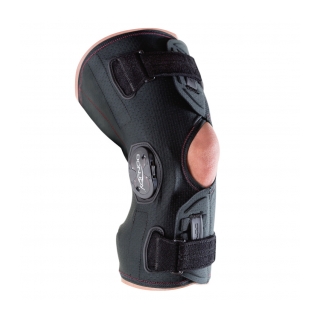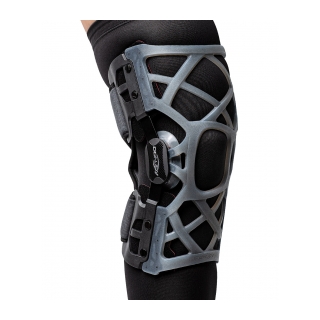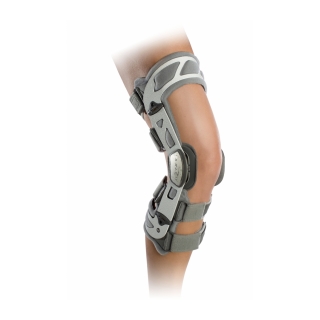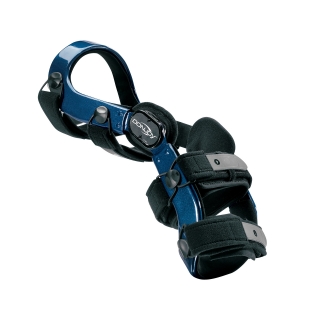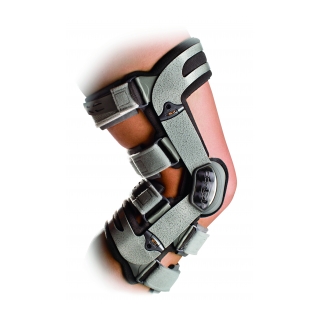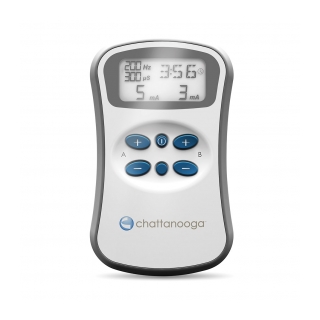Osteoarthritis & Your Knees
Osteoarthritis
& Your Knees
More than 27 million Americans have OA and the knee is one of the most commonly affected joints. There are many treatment options available including several non-pharmaceutical and non-surgical choices.1
What is OA of the knee?
Osteoarthritis is commonly known as “wear-and-tear arthritis,” but did you know that young people get it, too? Osteoarthritis, or OA, is the most common type of arthritis; it happens when the body’s natural cushioning—cartilage—wears away between joints. Think of cartilage as a shock absorber for your knees; less cushion results in bone rubbing against bone, and that can cause stiffness, pain, swelling decreased mobility and bone spurs. OA typically develops slowly and becomes worse over time. There is no cure for OA, but there are many treatments available that can ease the pain and help people to retain or regain their mobility.2
What Causes OA?
The ability of cartilage to heal decreases as people age, but the causes of knee OA vary. It can be hereditary or can be the result of injury, infection, overuse or excess weight.
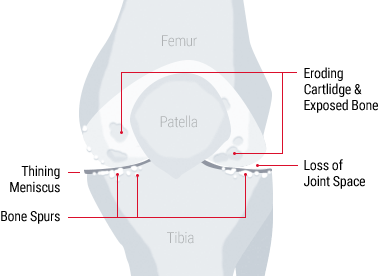
In osteoarthritis, the cartilage in the knee joint gradually wears away. As it does the protective spaces between the bones decrease resulting in bone rubbing on bone, producing painful bone spurs.
- Obesity is the No. 1 driver of knee OA and the No. 1 cause of disability in the U.S.
- Weak muscles around the knee can cause OA
- Every extra pound of weight adds 3 to 4 pounds of extra weight to the knees; extra weight increases pressure on knees
- Genetic mutations can make a person more likely to develop knee OA; abnormalities of bones surrounding the knee joint can also cause OA
- Women ages 55 and older are more likely to develop knee OA
- Athletes who play soccer, tennis or run long-distance may be at higher risk
- Activities that cause a lot of stress on the joint—kneeling, squatting, lifting heavy weights of 55 pounds or more—can cause OA of the knee due to repetitive stress
- Those with rheumatoid arthritis or metabolic disorders are at higher risk to develop knee OA3
Who Gets Knee OA?
- More than 27 million Americans have OA; the knee is one of the most commonly affected joints with more than 11 million people diagonosed in the U.S.
- Chances of developing OA increase after age 45 and according to the Centers for Disease Control, the average onset of knee OA is 55 years old. 1, 2, 3
- After an ACL injury, there is a predisposition for developing osteoarthritis (OA) 5 to 15 years after initial injury, regardless of surgical reconstruction.6
- As many as 80% of ACL injured knees will demonstrate OA, especially with concomitant meniscal damage.6
- More than 40 percent of knee replacements happen over the age of 65, so many people have to find other forms of conservative, non-invasive and non-addicting methods to control pain and maintain an active lifestyle.
- Women aged 55 and older are more likely than men to develop knee OA.
What Are My Options if I have Knee OA?
There are many options available for those with knee OA, including several that are non-pharmaceutical and non-surgical choices. You’ll want to talk with your health care provider about the treatment or combination of treatments that’s best for you; here are some you may want to explore and consider:
Did you know?
- Advanced braces prescribed and fitted by surgeons can be very effective at reducing pain; they work by offloading stress on the joint
- They are non-invasive and non-narcotic
- They can help you maintain your everyday activities like walking the dog, climbing stairs, gardening or exercising
- They can be used in tandem with other treatment options to manage OA symptoms, increase stability of the knee and reduce pain and swelling
- They can be more cost effective and safer than medications or more invasive surgeries that carry additional risks
- They can help further reduce deterioration of the joint by easing the pressure on the knee5
Motion is Medicine
- Activities; walking, strength training, swimming, biking, yoga, tai chi and other low-impact activities may help with pain and function of the knee
- Lighten up; a 2007 review found that overweight people who lost a moderate amount of weight had reduced pain and disability from knee OA
- Braces, sleeves other devices can help reduce pain and stiffness, take weight load off the affected joint and improve confidence and function for those with knee OA
- Transcutaneous electrical nerve stimulation, or TENS uses electrodes to send a mild current to the affected joint, which can help alleviate pain
- Acupuncture, balneotherapy (soaking in warm mineral springs) or heat or cold therapy may help ease joint pain for some people with knee OA
- Medications can include acetaminophen, nonsteroidal anti-inflammatory drugs (NSAIDs), topical NSAIDs, prescription medications, corticosteroid or hyaluronic acid injections and more
- Glucosamine and chondroitin sulfate, some studies have shown, can reduce pain and improve physical function; natural supplements, including avocado, soybean, capsaicin and turmeric, may have anti-inflammatory benefits for some people
- Joint replacement or joint-preserving surgery may be an effective option for some people2, 3, 4
How Can DonJoy Help?
If you have mild to severe knee OA and experience intermittent to chronic knee pain, or if you are not a candidate for surgery, ask your doctor about the science of bracing. DonJoy pioneered the concept of functional knee bracing more than 30 years ago and offers the most advanced technologies available.
Most importantly, they can help people return or continue to live an active lifestyle. No one person with knee OA is treated the same, so it’s important to look at all of the available solutions to find what is right for you. Some people may need a lot of off-loading capabilities, while others need just a slight push and comfort that surrounds the muscles around the knee.
Product Options from
DonJoy and the DJO Global Family of Brands
Neither DJO Global, Inc. nor any of its subsidiaries dispense medical advice. The contents of this website do not constitute medical, legal, or any other type of professional advice. Information related to various health, medical, and fitness conditions and their treatment is not meant to be a substitute for the advice provided by a physician or other medical professional. You should not use the information contained herein for diagnosing a health or fitness problem or disease. Rather, please consult your healthcare professional for information on the courses of treatment, if any, which may be appropriate for you.
- http://www.niams.nih.gov/Health_Info/Osteoarthritis/default.asp
- http://orthoinfo.aaos.org/topic.cfm?topic=a00212
- http://www.webmd.com/osteoarthritis/guide/ostearthritis-of-the-knee-degenerative-arthritis-of-the-knee
- http://www.webmd.com/osteoarthritis/guide/ostearthritis-of-the-knee-degenerative-arthritis-of-the-knee?page=2
- http://www.djoglobal.com/education/patient-education/oa-bracing-education
- https://www.hindawi.com/journals/aorth/2015/928301/

